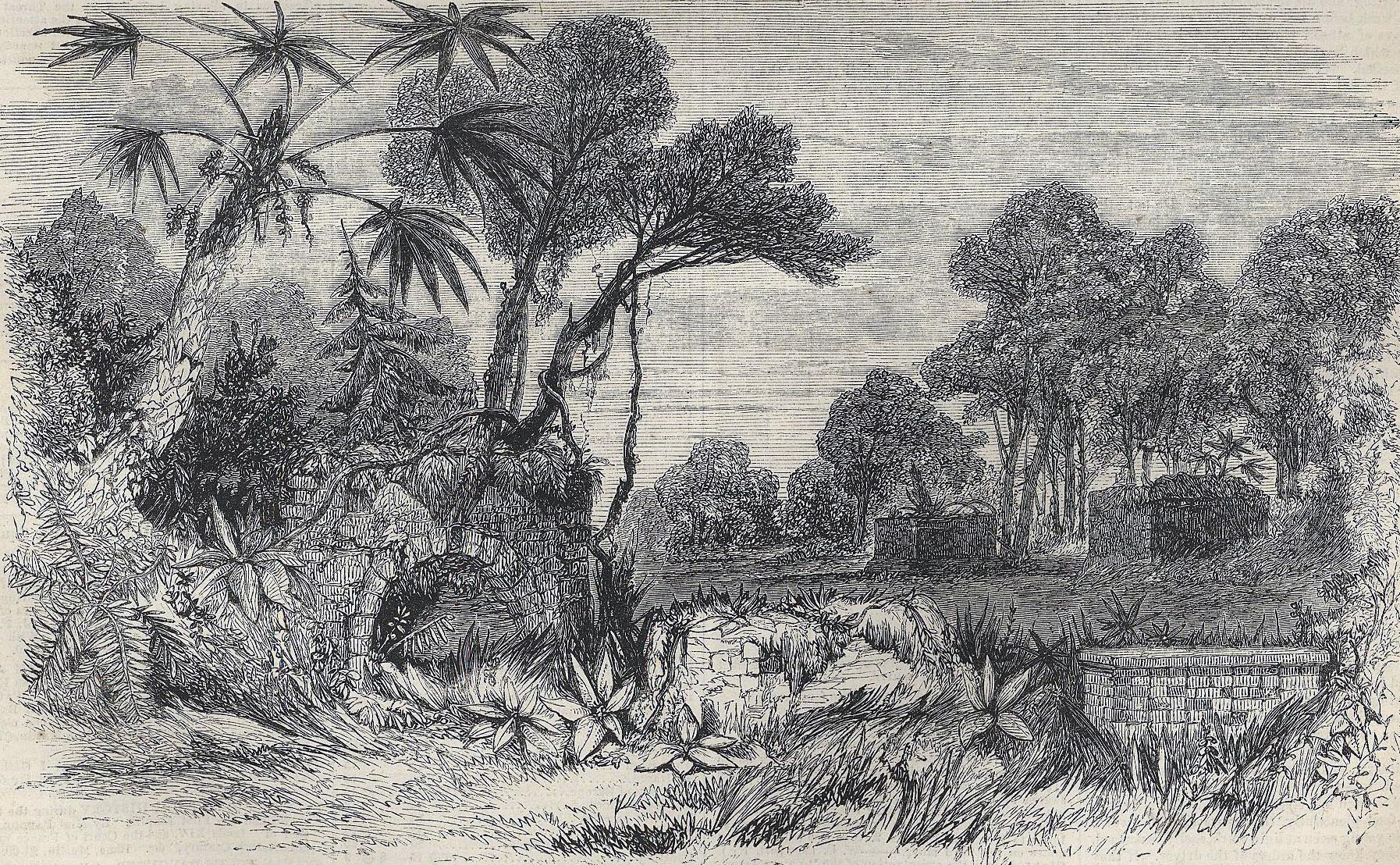

Oglethorpe's Barracks & Tombs
Harper's Weekly Vol. III No. 114
5 March 1859
 WE engrave herewith, from sketches furnished us by an attentive correspondent in
the South, the ruins of General Oglethorpe’s barracks at Frederica, St.
Simon’s Island, Glynn County, Georgia; also “Oglethorpe’s Tombs,” in
which lie the mortal remains of many of his officers and soldiers, the first
settlers of Georgia.
WE engrave herewith, from sketches furnished us by an attentive correspondent in
the South, the ruins of General Oglethorpe’s barracks at Frederica, St.
Simon’s Island, Glynn County, Georgia; also “Oglethorpe’s Tombs,” in
which lie the mortal remains of many of his officers and soldiers, the first
settlers of Georgia.
The events which give historic importance to Frederica occurred in
the year 1742. In that year the Spaniards entered the spacious and beautiful
harbor of Brunswick, with a fleet of thirty sail of Spanish armed ships, brigs,
etc., and landed some four or five thousand “veteran troops” of Spain to conquer
Georgia, and, if successful, to carry the war into the then colony of South
Carolina, and annex that noble province to the aspiring diadem of Spain.
To resist this overwhelming force General Oglethorpe had but
seven hundred effective men and about forty Chickasaw and Choctaw warriors. The
enemy effected an unopposed landing at a place then called Gascoin’s Bluff, near
the south end of the island, on the east bank of the south branch of the
Altamaha River, where it disembogues into Oglethorpe’s Sound, or
Brunswick harbor. The event, by-the-way, demonstrates most conclusively the
importance of fortifying this accessible port on the southern sea-coast of
Georgia, and establishing, with the least possible delay, the commanding
position of a naval depot at Blyth’s Island, recently purchased by government,
opposite the beautiful site of Brunswick.
The enemy were commanded by Don Arrodondo and Don Antonio,
and took up the line of march for Oglethorpe’s spacious intrenchments and
tabby fortifications at Frederica, situated on the east bank of the south
branch of the Altamaha, near the middle of St. Simon’s Island. At an early hour
in the morning, just as a bright Southern sun rose above the outer islands to
illuminate the scene of their utter defeat, the Dons, somewhat fatigued,
it is presumed, by their hasty and early march through a tangling chaparral,
bivouacked for a hot cup of coffee and breakfast as they entered on a spacious
marsh. Here Oglethorpe’s van of forty Chickasaw and Choctaw warriors and
a small detachment of vedettes opened a deadly fire on them as they sat on the
ground devouring their meager ration. Many left their arms on the spot, while
others fled for the path they had left, and were rejoiced to find themselves
once more safe at Gascoin’s Bluff. In the mean while two brigs of twenty guns
each had been sent up the river to attack Oglethorpe by water at
Frederica. Their heavy cannonade compelled our gallant commander to hasten back
from the pursuit of the Spaniards to defend his works at Frederica. He soon
compelled the bombarding brigs to slip their cables and make all sail for
Gascoin’s Bluff.
Meanwhile the Spanish leaders, chagrined by their rapid retreat from
Bloody Marsh (the name it has ever since received, and still retains), rallied
their troops, which the war-whoops of the furious Chickasaws and Choctaws had
nearly rendered frantic, and urged them on to attack Oglethorpe in his
strong-hold at Frederica. They were crossing an extensive savanna, or prairie,
in advance of Frederica, when Oglethorpe, who lay in ambush in a thick
wood (where our church now stands), poured into their compact columns a
most deadly fire. Here tradition relates that Tomo Chichi, the brave and
dauntless chief of the Chickasaws and Choctaws, became personally engaged with
Captain Sanches of the Spanish army. The latter drew a pistol and shot
the chief in the arm. The Indian had just discharged his rifle, and seizing his
tomahawk, cleaved Sanches’s skull in twain. The enemy were again most
thoroughly defeated; but our cautious General, unwilling to expose his feeble
force, allowed them to retreat to Gascoin’s Bluff and re-embark on board their
shipping. They spread all sail for St. Augustine, when the Spanish chimera of
conquering Georgia was forever abandoned.
In the tombs herewith depicted rest some of the brave men whose
efforts saved Georgia from becoming a Spanish province, as the Floridas were at
that time. Their memories, like their names, have been forgotten by history.
In a field to the rear of these barracks bomb-shells and hollow shots have been
plowed up, and a boxful of them sent to the Historical Society of Savannah,
where they remain unnoticed. These tombs are called Oglethorpe’s Tombs,
although he died in England. Their tenants were his officers, soldiers, or
citizens, the first settlers of the country.

Home
Contact
Site Map
Copyright ©GlynnGen.com All Rights Reserved
Material on this site is one of kind,
having been published here for the first time ever. This data was compiled by
Amy Hedrick
for the GlynnGen website to be used for your personal use and it is not to be
reproduced in any manner on other websites or electronic media,
nor is it to be printed in any resource books or materials. Thank you!
Want to make a contribution?
Donate via PayPal: